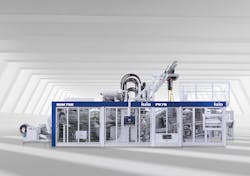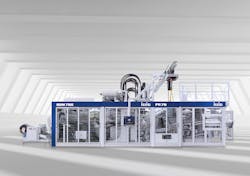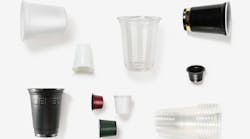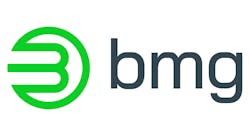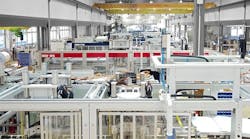The RDM 76K 4G includes a redesigned PH 76 product handling device that allows direct linkage with different end-of-line packaging solutions.
The new machine for forming and punching operations debuted at K 2019.
Conor Carlin, managing director of Illig LP, the Indianapolis-based U.S. subsidiary of Illig, said the machine has a completely redesigned double servo drive that enables faster movement times and faster cycles.
“On the lower forming table, the drive system is powered by two separate servos, one for the lifting movement and one for the swiveling/tilting movement,” he said. “This results in lower vibration, high rigidity and high forming speeds for larger, heavier tools.
“On the upper forming station, the plug-assist system has been redesigned from a single-servo-drive system to a fully synchronized double-servo system. This was done to increase both the plug stretching force — for deeper parts and/or thicker material — and the plug stroke.”
A center support was added to the lower machine table that increased tool closing force by 50 percent to about 101 tons. Because of this, the available cutting length can also be increased by up to 50 percent. Service life is also improved and productivity has increased, the company said.
The new model has a forming area of about 2.5 feet by 1.8 feet. The maximum material width is 3 feet. The maximum cycle speed is 40 cycles per minute.
The RDM 76K is especially suited for products with a high draw ratio and part height of up to 10 inches. At K 2019, an RDM 76K produced drinking cups made from recycled PET.
A more powerful heating system means the RDM 76K can process sheet as thick as 3mm.
The previous generation had a 67-ton tool closing force, maximum material width of 33.5 inches and part height of 5.9 inches.
The new thermoformer processes film directly from a roll or in line when connected to an extruder. It combines in-place forming and pass-through punching tools, which means the part is formed and cut in a single station.
Parallelism of the upper and lower tables is accomplished electronically.
An integrated tool block change system reduces tool changes to less than one hour, Illig said.
Total length of the line is reduced compared with previous versions.
Illig offers secure remote monitoring of its machines to help processors with troubleshooting and to reduce downtime.
The PH 76 has been reconfigured to require less floor space.
“The fact that the PH 76 can now link to other end-of-line solutions is important because in the previous generation, the user had to move the entire PH system in the direction of the machine, which led to difficulties for downstream automation,” Carlin said. “The new design allows for transversal movement of the transfer device that takes the formed parts from the mold to the stacker. The PH unit does not move.”
Illig also unveiled its new RDKL in-mold labeling unit it claims can decorate lids at 20 percent lower cost than injection molding machines because of weight savings, higher output and lower machinery investment cost. The unit is compatible with Illig thermoformers.
The new unit has a forming area of 29.8 inches by 22.2 inches, a maximum molding height of 4.7 inches and maximum speed of 24 cycles per minute.
“The RDKL is an entirely new concept for thermoforming,” Carlin said. “Illig’s work in this space until now has been on RDML systems, or IML units for tilt-mold machines that are typically making pots, tubs, oval or square containers.
“The RDKL now allows labels to be placed on lids and shallow trays which can be aligned with other formed parts,” Carlin said.
He said examples in the U.S. market would be certain hummus containers and butter containers. Instead of forming parts and then sending them to an offset printer or a separate labeling system, the Illig design allows the user to do everything in one machine, he said.
The RDKL labeling unit is modular and can be removed if the user is forming parts that do not require decoration.
Carlin said he expects strong interest from North American customers for the RDM 76K 4G. “The new design responds to several key requests, including punching force and maximum part depth,” he said.
Carlin also said there were “serious inquiries for the RDKL system” at the K show, but in-mold labeling for thermoforming is “still considered a novelty in the U.S.”
Ron Shinn, editor
Contact:
Illig LP, Indianapolis, 855-824-0004, www.illig-group.de
